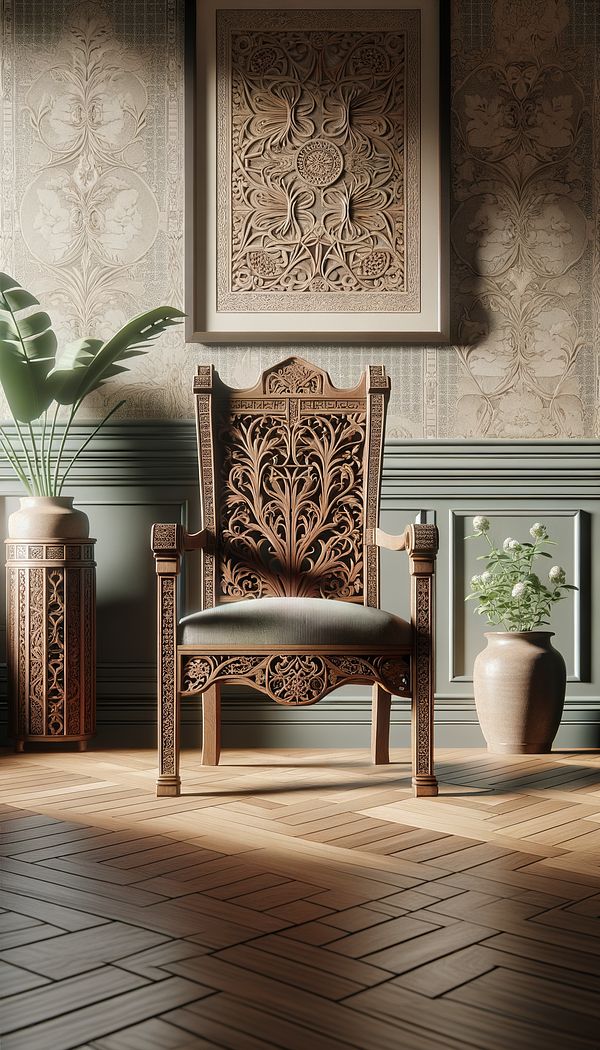What is Eastlake?
Eastlake is a design movement named after Charles Eastlake.
Description
Eastlake is a design movement and style that originated in the late 19th century, named after its proponent, Charles Lock Eastlake. Eastlake, an English architect and writer, advocated for a departure from the excessively ornate furniture and interior design styles that were popular during the Victorian era. Instead, he championed simpler, more handmade elements, emphasizing craftsmanship and less cluttered design aesthetic. His ideas were published in his influential book, "Hints on Household Taste in Furniture, Upholstery, and Other Details," first released in 1868.
The Eastlake style is often characterized by incised, geometric decorations, lightly carved details, and a focus on the true structure and materials of furniture. It maintains an overall simple yet functional aesthetic, avoiding heavy ornamentation in favor of a more straightforward approach to design. Furniture pieces might feature turnings, bracket supports, and innovative joinery techniques that underscore the beauty of their construction. Textiles and wallpaper used within the Eastlake context tend to be of a simpler design, often incorporating botanical or geometric patterns that complement the furniture’s decorative elements.
This style has inspired modern interior designers by encouraging a balance between beauty and pragmatism, while also advocating for a return to authenticity and craftsmanship in design.
Usage
Eastlake furniture and design elements are often seen in vintage and antique shops. Interior designers may incorporate Eastlake pieces, such as chairs, tables, or sideboards, into modern settings, leveraging their elegant yet straightforward designs. Upholstery and wallpapers inspired by Eastlake’s principles also contribute to creating rooms that resonate with a sense of history yet feel refreshingly uncluttered.
FAQs
-
Who was Charles Eastlake?
Charles Lock Eastlake was an English architect and writer known for his influence on the Eastlake design movement, emphasizing simplicity and craftsmanship in furniture and interior design.
-
What are characteristic features of Eastlake design?
Characteristic features include incised, geometric decorations, lightly carved details, a focus on structural beauty and craftsmanship, and less cluttered design aesthetics.
-
How does Eastlake design compare to Victorian style?
Eastlake design offers a simpler, more functional aesthetic that focuses on craftsmanship and structures, contrasting with the often more elaborate and heavily ornamented Victorian style.
-
Can Eastlake elements be incorporated into modern interior design?
Yes, Eastlake elements like furniture and wallpapers can beautifully complement modern interiors, providing a sense of history while maintaining a clean and uncluttered aesthetic.
Practical Application
Incorporating Eastlake design elements into modern interior spaces can add a touch of historical elegance while keeping the overall aesthetic fresh and uncluttered. Focus on selecting furniture pieces with geometric details and craftsmanship that speak to the Eastlake ethos. Complement these with textiles and wallpapers that echo the simplicity and refined taste characteristic of the movement for a cohesive look.
-
Design Styles478 articles
-
Furniture Types599 articles
-
Decorative Techniques322 articles
-
Historical Periods & Movements150 articles
-
Decorating Principles & Elements330 articles
-
Block FootBlock Foot is a type of foot design used in furniture.
-
DecoratorIn interior design, a decorator focuses on enhancing the aesthetic appearance of a space.
-
Continuous CoilContinuous Coil refers to a engineered construction method used in mattresses and upholstery.
-
VaultA vault is an architectural element consisting of a curved structure designed to provide a space with a ceiling or roof.
-
TraditionalTraditional interior design is a timeless style that emphasizes classic, symmetrical arrangements and rich details.
